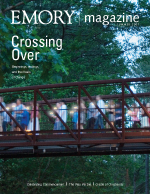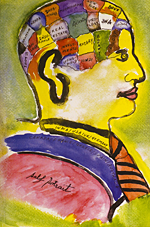Autumn 2007

Letters
I am at home this morning and without my trusty typewriter, but I am so excited over the summer issue that I want to congratulate you from front to back. You visited the Melendis in Florida; I remember Shannon’s death so well, and you created a touching story. I read “Changing the Way We Die,” every word of it. The “Planning for a Better Death” [sidebar] set me to thinking about something I’ve neglected at age ninety-five. I could bore you with another page of specifics, but I will finish with the climax: “Windows,” the real story by a son about the career of a 1931 Emory law graduate in Mobile. I have read pages 46 and 47 three times. What an ending! You have put together a real classic.
Jake Ward 33C 36G
Emory Dean of Alumni
Nobody who has experienced hospice care can doubt that it is a significant source of help at a difficult time. Our problem here in Montgomery has been in convincing state government that in-home hospice care not infrequently needs to be supplemented by care which is best given in dedicated inpatient hospice homes. The articles in the most recent issue are excellent statements of our case for both hospice care and inpatient hospice home care.
Arthur Mazyck
Medical School Faculty, 1970–1973
President, Board of Directors, Hospice of Montgomery, Montgomery, Alabama
My thanks to you for the summer issue of Emory Magazine, which so delighted me. I really appreciate receiving extra copies of that issue to share with my friends. Many of them are, like me, facing the end-of-life decisions that these articles [“The Way We Die”] deal with. It was wonderful the way each section of the magazine dealt with those issues from the patient’s point of view and then culminated in the beautiful words of Margaret Blevins, a hospice chaplain. Having been a hospice volunteer for many years, I was moved by the truths that were presented.
Betty F. Vanta
Decatur
I am glad to see the excellent articles on “The Way We Die.” As an addition, I suggest consideration of the problems of those who are bereaved. Quite often they suffer physical and emotional exhaustion. In relation to their loved ones, they can become confused about how to speak and act. Inhibitions and feelings of guilt are common. One of the most frequent regrets is having left the bedside—even if only briefly—at the moment of death. Some of these problems can be alleviated by wise counsel at the appropriate time. A good article on the subject would be very helpful.
Bill Williamson 42G
Madison, Wisconsin
I wonder how we could revise our approach to health care that would include a broader view rather than just the scientific perspective? Life and death are inseparable, and there will always be new challenges. It was about halfway into my nearly twenty-year career in bone marrow transplant that I began to really acknowledge that a significant percentage of our patients die. A few years ago, I was caring for a patient during a long hospitalization and was with him shortly before he died. I had the profound experience that I, too, would one day cross this same threshold. This encounter brought me into intimate contact with my own personal fear of death, the unknown, suffering, disability, loss of control, as well as the sense of professional failure and helplessness that can occur when a patient is dying. To sit with our patients through their illness we must be able to sit with ourselves.
Laurie J. Wright, 88PA
Emory Hospital
I write in response to the three letters [regarding “The Most Difficult Kind of Work,” spring 2007]. I support Jimmy Carter and his book. His thoughts came from his personal experiences and studies. I admire him for speaking his mind on the subject without fear of the rock throwers who do come. I have been a member of Christians for Peace and Justice in the Middle East since its founding more than five years ago. With a conscious effort to be balanced and impartial, we have come to much the same conclusions as did President Carter in Palestine Peace Not Apartheid. I trust his character, his devotion to truth, his devotion to humankind, his caring for all peoples, his towering intellect, his courage.
James L. Ray 45C 49T
Franklin, Indiana
I am eternally grateful to President Carter for his witness as a man of truth and courage. I am very proud to have him as our statesman of the progressive South. His courage has been displayed countless times and in every instance his has been a clear and most honorable voice for compassion and peace. If any human being has earned the right to be heard regarding his understanding of what is occurring in the Middle East between Palestine and Israel, it is he. Thank you, Emory, for providing that platform for all of our benefit.
Bob Windom 73T
Atlanta
As parents of a rising 2008 senior, we read with interest the story about the 2007 Commencement, looking forward to our own family’s celebration next May. But the statistics box caught our eye, and we were astonished to read that 48.8 percent of the grads were males, with 57.2 percent female! Now maybe the current fertility clinic advances can create such astonishing results [“New Beginnings”] but we doubt it. We humble grads of TCU and OU still think there is only 100 percent, and we hope Emory’s math instructors reach similar results.
Linda Newman 08P and Steven Page 08P
Dallas, Texas
Editor’s Note: The Class of 2007 was 42.8 percent male and 57.2 percent female. Many thanks to Ms. Newman and Mr. Page for bringing this error to our attention.
Write to us

Has something in Emory Magazine raised your consciousness—or your hackles? Write to the editors at Emory Magazine, 1762 Clifton Road, Plaza 1000, Atlanta, Georgia, 30322, or via email at paige.parvin@emory.edu. We reserve the right to edit letters for length and clarity. The views expressed by the writers do not necessarily reflect the views of the editors or the administrators of Emory University.
Editor’s note: Arun Misra 96P, of Alpharetta, Georgia, a former professor of biology, financial planner, and real estate agent, created the illustration (right) that accompanied an article on Alzheimer’s disease in the summer 2007 issue.